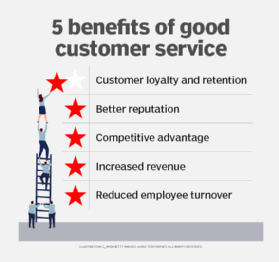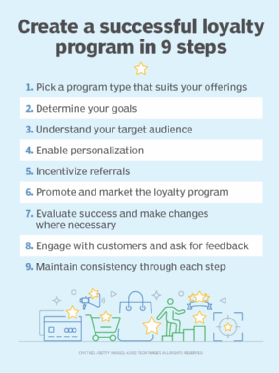
Getty Images/iStockphoto
10 tips to improve customer retention
Organizations that properly gather consumer feedback, get to know their customers and offer rewards to loyal shoppers can improve their customer retention rates.
Customer retention is crucial for the sustainable growth of any business.
Retaining existing customers is more cost-effective than acquiring new ones, helps build a loyal customer base and can increase profits. With tactics such as collecting and analyzing customer data, prioritizing customer service, engaging with customers on multiple channels and embracing personalization, organizations are more likely to retain customers and gain their long-term support.
Explore best practices and strategies that organizations can implement to improve customer retention rates.
1. Collect customer feedback
Organizations capture customer feedback in various ways -- including surveys and polls -- to better understand customers' pain points or potential issues.
Surveys
Online surveys. CX teams can send out surveys over email or publish them on their website to reach a broad audience. Tools like SurveyMonkey or Google Forms can create and distribute these surveys.
In-app surveys. If the business has a mobile app, it can integrate surveys directly within the app to capture feedback at key moments in the user journey.
Customer satisfaction surveys. These short surveys typically ask customers to rate their satisfaction with a product or service on a numerical scale.
Polls
Social media polls. Social platforms like X, LinkedIn or Instagram can conduct quick polls and gauge customer opinions on various topics.
Website polls. Polls on the brand's website can capture visitor opinions in real time.
Direct feedback mechanisms
Customer service interactions. Customer service representatives should ask for feedback at the end of interactions, through follow-up emails or after-service calls.
Feedback forms. Feedback forms on the brand's website or mobile app enable customers to share their thoughts and experiences anytime.
2. Prioritize customer service
Customer service is the key to customer retention. In a competitive marketplace, the quality of customer service can significantly influence a customer's decision to remain loyal to a brand or switch to a competitor.

Exceptional customer service requires organizations to properly train their service teams. This involves comprehensive training programs that cover technical aspects of the brand's products or services, and soft skills, such as communication, empathy and problem-solving. Ongoing training can also keep staff updated on new products, services and policies, so they can resolve issues effectively.
Customer service also benefits from empathy and quick resolutions. When service reps show empathy and acknowledge the customer's feelings and concerns, they build a stronger connection and make customers feel valued.
Additionally, customers expect quick and efficient resolutions to their problems. Tools like CRM software can streamline query management, enabling faster and more organized responses. Automation tools can also help free up time for reps to focus on more complex issues and ensure they promptly address all customer queries.
3. Use personalization
Personalization can make customers feel valued and understood, which can boost customer loyalty and satisfaction. In fact, consumers are more likely to become repeat buyers after a personalized experience.
CX teams -- particularly marketers or customer service reps -- can use customer data analytics to tailor communications, offers and services to meet individual customer preferences, or to properly handle service queries that arise.
4. Get ahead of churn
CX teams must identify and address potential churn risks before they become issues. They can use tactics like predictive analytics to spot early signs of customer dissatisfaction and take proactive measures to retain those customers.
Additionally, an organization may want to build a customer success team, which can communicate with customers regularly and offer solutions to their problems to prevent churn.

5. Implement customer loyalty programs
Customer loyalty programs incentivize repeat business, as they offer rewards, discounts and exclusive deals to loyal customers. These programs can create a sense of belonging and appreciation from customers, which can encourage them to stay with the brand.
6. Embrace automation
Automation can enhance customer retention, as it streamlines processes and ensures timely follow-ups. Common automation tools that businesses use include the following:
- Email marketing.
- Customer service responses.
- Personalization.
- Reporting and analytics.
Overall, automation helps maintain consistent and efficient customer interactions across various channels.
7. Offer value beyond the product
Many organizations offer value-added services that go beyond their core products, which are only available to customers who have made a purchase. These services can include the following:
This type of additional value can benefit customers and ensure they place the business ahead of its competition.
8. Create a strong community
Building a community around the brand can drive customer loyalty. For example, social media, forums and events can engage customers and give them an opportunity to interact with the brand and other consumers, whether in person or online. A strong community can provide support and enable members to share experiences and build lasting relationships with a brand and each other.
9. Continuously improve business strategies
Organizations should always ensure their marketing, sales, service and other core strategies are relevant and up to date. To accomplish this task, they can regularly incorporate customer feedback to see what works well and what doesn't. Businesses that make tangible changes based on user input can show those customers their opinions matter, which can benefit customer satisfaction and retention strategies.
10. Incentivize long-term engagement
Organizations that offer incentives for repeat purchases often get customers to stay with them long-term, as they motivate customers to continuously engage with the brand.
Incentives can include the following:
- Tiered rewards programs.
- Free trials, samples, products or upgrades.
- Referral bonuses.
- Special recognition for long-term loyalty.
Key takeaways
Improving customer retention is both a strategy and a comprehensive approach that requires CX teams to understand and meet customers' needs consistently.
Ultimately, an organization should aim to create a seamless and positive customer journey that turns satisfied customers into loyal advocates. Organizations that prioritize these strategies can improve their customer retention rates and drive sustainable growth and profitability.
Investing in customer retention is a cost-effective way to ensure a business thrives in a competitive market, and acts as a reminder of the importance of happy, engaged customers.
Robert Peledie is the director of CRM consultancy 365Knowledge Ltd., with years of consulting experience in global organizations.







